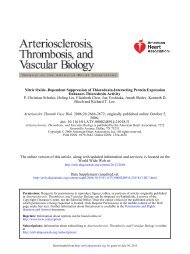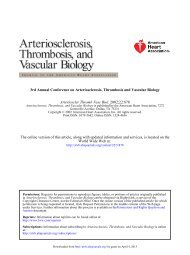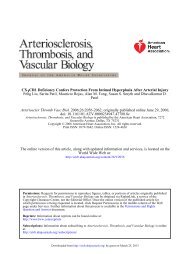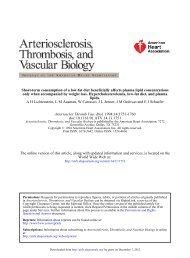Physiologic and Supraphysiologic Increases in Lipoprotein Lipids ...
Physiologic and Supraphysiologic Increases in Lipoprotein Lipids ...
Physiologic and Supraphysiologic Increases in Lipoprotein Lipids ...
Create successful ePaper yourself
Turn your PDF publications into a flip-book with our unique Google optimized e-Paper software.
<strong>Physiologic</strong> <strong>and</strong> <strong>Supraphysiologic</strong> <strong>Increases</strong><br />
<strong>in</strong> Lipoprote<strong>in</strong> <strong>Lipids</strong> <strong>and</strong> Apoprote<strong>in</strong>s<br />
<strong>in</strong> Late Pregnancy <strong>and</strong> Postpartum<br />
Possible Markers for the Diagnosis of "Prelipemia"<br />
Agust<strong>in</strong> Montes, Carolyn E. Walden, Robert H. Knopp, Marian Cheung,<br />
Margaret B. Chapman, <strong>and</strong> John J. Albers<br />
A supraphysiologic (>95th percentile) rise <strong>in</strong> plasma lipids <strong>in</strong> pregnancy may serve<br />
as a marker for "prelipemia" <strong>in</strong> the same way that gestational diabetes is a marker for<br />
prediabetes. To qualify as prelipemic, subjects with an abnormal lipid rise antepartum<br />
must return to normal postpartum but may have other identify<strong>in</strong>g characteristics. This<br />
paper describes the antepartum-postpartum changes of lipoprote<strong>in</strong> lipids <strong>and</strong> apoprote<strong>in</strong>s<br />
at 34 to 38 weeks of gestation <strong>and</strong> 6 <strong>and</strong> 20 weeks postpartum <strong>in</strong> 23 subjects<br />
with physiologic <strong>and</strong> six subjects with supraphysiologic plasma lipid <strong>in</strong>creases dur<strong>in</strong>g<br />
pregnancy. These results are compared to measurements <strong>in</strong> 23 nonpregnant<br />
controls matched for weight, age, <strong>and</strong> race. In subjects with a physiologic antepartum<br />
lipid rise, postpartum total triglyceride <strong>and</strong> very low density lipoprote<strong>in</strong> (VLDL) lipids<br />
(cholesterol <strong>and</strong> triglyceride) <strong>and</strong> apo B returned to basel<strong>in</strong>e with<strong>in</strong> 6 weeks. In contrast,<br />
low density lipoprote<strong>in</strong> (LDL) showed a slow postpartum decl<strong>in</strong>e <strong>in</strong> lipids <strong>and</strong><br />
apo B with elevations rema<strong>in</strong><strong>in</strong>g at 20 weeks postpartum. High density lipoprote<strong>in</strong><br />
(HDL) cholesterol concentrations, elevated <strong>in</strong> pregnancy, rema<strong>in</strong>ed elevated at 6<br />
weeks postpartum, but fell to basel<strong>in</strong>e by 20 weeks postpartum. HDL triglyceride <strong>and</strong><br />
apo A-l concentrations, both elevated <strong>in</strong> pregnancy, returned to basel<strong>in</strong>e by 6 weeks<br />
postpartum. A supraphysiologic triglyceride rise <strong>in</strong> pregnancy was associated with a<br />
slower return of total triglycerides <strong>and</strong> VLDL to basel<strong>in</strong>e, reduced HDL cholesterol<br />
ante- <strong>and</strong> postpartum, atypical changes <strong>in</strong> LDL cholesterol dur<strong>in</strong>g pregnancy <strong>and</strong><br />
postpartum, <strong>and</strong> evidence of hyperlipidemia among family members. Two subjects<br />
with hypercholesterolemia <strong>in</strong> the nonpregnant state showed no marked exaggeration<br />
of total or LDL cholesterol concentrations <strong>in</strong> pregnancy. The data support the hypothesis<br />
that a supraphysiologic rise <strong>in</strong> plasma triglyceride concentrations <strong>in</strong> late pregnancy<br />
may serve as a marker of prelipemia. Proof of the hypothesis requires further<br />
<strong>in</strong>vestigation <strong>and</strong> longer follow-up.<br />
(Arteriosclerosis 4:407-417, July/August 1984)<br />
Glucose <strong>in</strong>tolerance <strong>and</strong> hyperlipidemia are physiologic<br />
accompaniments of normal pregnancy.<br />
12 With respect to glucose homeostasis, it is well<br />
known that some women manifest overt diabetes<br />
under the stress of pregnancy but revert to normal<br />
after delivery. The deterioration of glucose homeo-<br />
From the Northwest Lipid Research Cl<strong>in</strong>ic <strong>and</strong> the Department<br />
of Medic<strong>in</strong>e, School of Medic<strong>in</strong>e, University of Wash<strong>in</strong>gton, <strong>and</strong><br />
the Department of Biostatistics, School of Public Health <strong>and</strong> Community<br />
Medic<strong>in</strong>e, Seattle, Wash<strong>in</strong>gton.<br />
This work was supported by the Lipid Research Cl<strong>in</strong>ic Program<br />
Contract HL 12157 <strong>and</strong> Grant HD 08960 <strong>and</strong> by the Council for<br />
Tobacco Research, USA. Dr. Albers is an Established Investigator<br />
of the American Heart Association.<br />
Current address for Dr. Montes: Catedra 2, de Fisiologia, Facultad<br />
de Medic<strong>in</strong>a, Cuidad Universitaria, Madrid 3, Spa<strong>in</strong>.<br />
Address for repr<strong>in</strong>ts: Robert H. Knopp, M.D., 326 N<strong>in</strong>th Avenue,<br />
Seattle, Wash<strong>in</strong>gton 98104.<br />
Received August 17, 1983; revision accepted March 14, 1984.<br />
407<br />
stasis <strong>in</strong> pregnancy, known as gestational diabetes,<br />
134 is considered to be a form of prediabetes<br />
because it predicts later progression to overt diabetes<br />
with a high degree of accuracy. 4 It is not yet<br />
known if a similar deterioration of lipid homeostasis<br />
occurs <strong>in</strong> pregnancy, reverts to normal postpartum,<br />
<strong>and</strong> predicts the appearance of overt nongestational<br />
hyperlipidemia years later. Such a condition might be<br />
termed "prelipemia" <strong>and</strong> if identified would provide<br />
an important tool to study the natural history of hyperlipidemia<br />
from its earliest stages.<br />
This paper presents <strong>in</strong>formation to support the<br />
hypothesis that prelipemia is identified by a supraphysiologic<br />
lipid rise <strong>in</strong> pregnancy. The postpartum<br />
return of plasma lipids <strong>and</strong> lipoprote<strong>in</strong>s to basel<strong>in</strong>e is<br />
described <strong>in</strong> normal subjects. These results are compared<br />
to women with supraphysiologic elevations <strong>in</strong><br />
triglyceride or cholesterol <strong>in</strong> pregnancy but with de-<br />
Downloaded from<br />
http://atvb.ahajournals.org/ by guest on June 29, 2013














